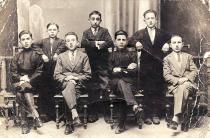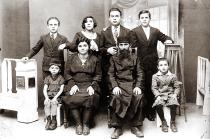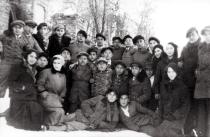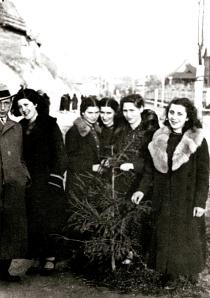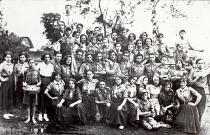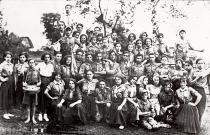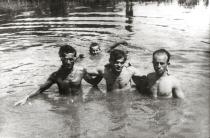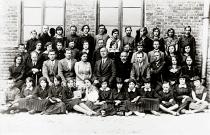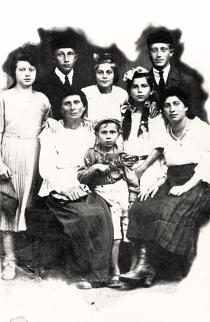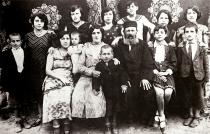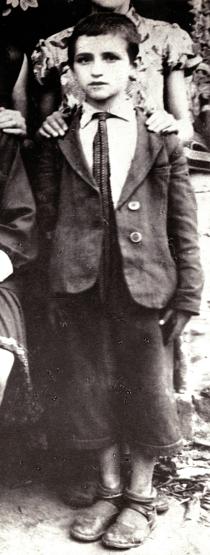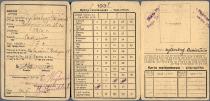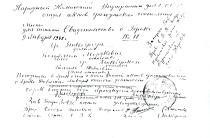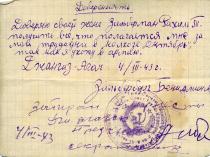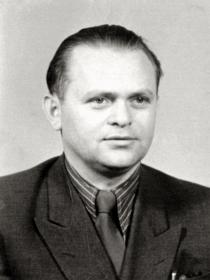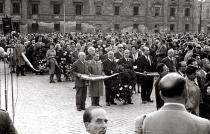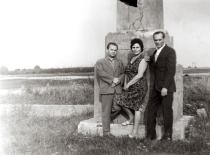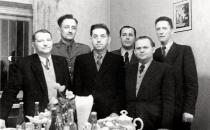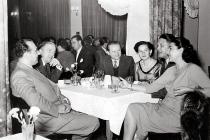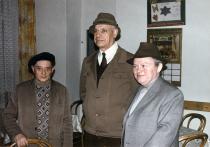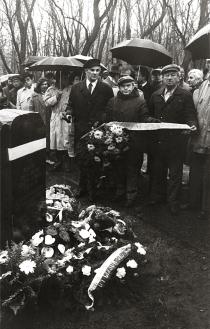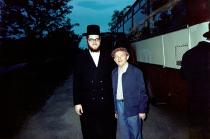
Beniamin Chaim Zylberberg
(Boleslaw Janowski)
Warsaw
Poland
Interviewer: Jacek Borkowicz
Date of interview: December 2003 - January 2004
Beniamin Zylberberg, since the war Boleslaw Janowski, is a retired civil servant. He lives alone in Warsaw; his wife died a few years ago. In spite of his age he has retained his vigor and equanimity. He enjoyed talking about his youth, which he spent in a small town in the Lublin province. He holds left-wing, atheistic views but has always felt Jewish.
My family background
Growing up
During the War
After the War
Glossary
My official name is Boleslaw Janowski, but I was born Beniamin Chaim Zylberberg on 19th February 1916 in Krasnik Lubelski. I changed my name after the war to make my life in a non-Jewish society easier. My father, Mordechaj Zylberberg, was born in Ozarow Kielecki, about 40 kilometers from Krasnik, around 1884 - 85. My mother, Hinda, nee Nyrenberg, was born in Krasnik around 1888 - 89. My father had a furrier and cap-making workshop, while my mother simply kept house: she maintained a traditional Jewish kitchen and bore children. My parents were very religious. My father dressed traditionally, kept his head covered and wore a kaput [caftan]. He was never without a cap. He was a Hasid 1, a member of the Lubliner Rebbe’s circle. The only school my parents went to was cheder. They could read the prayer book, but they certainly couldn’t write in Hebrew or Yiddish. I don’t know how they met and got married, but I’m certain that the marriage was arranged by a shadkhan.
Ninety percent of the clientele in my father’s workshop were Poles, because Jews only bought his black caps for the holidays: Pesach, Rosh Hashanah and Yom Kippur, but the Poles came in frequently. My father knew a few words of Polish and was able to communicate with his Polish clients, and the clients could usually understand a little Yiddish. But my father couldn’t speak Polish, and my mother had nothing at all to do with it [the Polish language], because she didn’t get involved in matters to do with the workshop or the business. They had both been brought up among people who spoke only Yiddish.
There were seven of us children. Two died a few days or weeks after being born, and five survived: my eldest brother Mojsze was born in 1908, Wigde, younger than him, was born about two or three years later, I was the third, and the fourth, Duwydl, younger than me, was born in 1920 or a little later, and the youngest was a girl, Surel. I don’t know exactly when she was born, but I remember that before the war she had started to go to elementary school, so she was seven or eight. Mojsze got married in 1932 to Lybaly Lederwerk from Ozarow Kielecki, who moved to Krasnik, where my brother built himself a little brick house out of her dowry, about one kilometer from our cottage. He sold fabrics for clothes there, measured in ells and so his shop became known as ‘lokciowka’ [the Ellery]. Mojsze and Lybaly had a little girl, a very pretty child, I remember her well. Wigde married too, when I was in jail. Like my father, he worked in a furrier and cap-making workshop, somewhere in Wielkopolska [province in northwestern Poland].
My maternal grandfather was called Duwyd Nyrenberg. He died in Krasnik in 1926 or in 1927. I don’t remember him very well. He dressed traditionally; he was very religious – an Orthodox 2. I remember that he had a long beard, but what Jew didn’t have a beard at that time? I remember his funeral better, because of a certain unpleasant incident. We carried my grandfather’s body from the synagogue to the Jewish cemetery through the side streets, because the Krasnik authorities had prohibited Jewish funerals from passing through the main square of the town. And all around the square lived almost only Jews. There were a few Christian houses and shops too, but about ninety percent were Jewish shops and cottages. In that little town, out of 8,000-10,000 residents, half were Jews. Grandmother Gitel, Duwyd’s wife, wore a wig and was dressed in dark clothes. She had a little shop on the square in Krasnik, where you could buy a few needles, a bit of thread, and clay pots. Grandfather Duwyd didn’t make the pots himself, somebody brought them to him. I would often go to see my Grandmother on the square for a few groszy. I remember too that she told me some fairytales at home.
I don’t remember my grandmother’s death, but I do know that she was still alive in 1935 when I was arrested. In prison I wasn’t told of her death and I wasn’t at her funeral. They were both born in Krasnik. They spoke only Yiddish. My grandmother may have known a few words of Polish, because some of her Polish customers must have spoken to her in that language. They only had a religious education. I don’t consider them illiterate since they could read prayer books. And that wasn’t in Yiddish but in Hebrew, ‘lushn-koydesh’ [Yiddish: ‘the holy language’]. But they couldn’t write. I didn’t know my paternal grandparents, who lived in Ozarow. I very rarely went to Ozarow, and they never came to Krasnik.
My father’s sister, Binaly, also had a large family. In 1920 my father took her and all her family to Palestine. When in the 1980s I was able to go to Israel for the first time, Aunt Binaly was no longer alive, but I met her large family. Her granddaughter came to Poland recently with her husband, who is an AIDS specialist; he’s called Izrael Just, and lectures in Tel Aviv, the United States, Canada and England. So thanks to my father’s wisdom I still have relatives in Palestine to this day. Though on the other hand, if my father had stayed there too, then my family would have survived. But he came back to Poland, where all of them, about ten people, except me, died. I don’t even know where they were burned. I remember an uncle, too, my mother’s brother, who was called Eli Nyrenberg and was a melamed in one of Krasnik’s cheders. His wife was called Ity. My mother also had two other brothers, who immigrated to the United States before World War I.
In Krasnik we lived in a wooden cottage near the square, on Krotka [Short] Street, which really was short. But I don’t remember the number. Were there numbers there at all? Our house was a single-story house, although above us, on a low mezzanine, lived another Jewish family. Some 200 to 300 meters from the square was the synagogue, and next to it a prayer house. That was open every day, but the synagogue only on Saturdays and holidays. From there was a road that led to the Jewish cemetery, the ‘kirkut’ [the Polish name for a Jewish cemetery] or ‘heilike ort,’ which in Yiddish means ‘holy place.’ It was nearby; you just had to cross the river.
My earliest memories go back to 1920, when during the Polish-Bolshevik War 3 the Bolsheviks 4 came almost into Krasnik. The people in our town made themselves all kinds of shelters. In our house we made our attic into a shelter. I remember waiting in the attic with my family for the front to pass.
All my friends were Jewish, from the neighboring cottages. In the vicinity of our house there was a cheder, which I started attending at age five or six. Classes were in the morning. There were 30 boys minimum in my class. But I didn’t like that cheder somehow. There was this melamed there, we called him Kanczuk [‘kanczuk’ is a whip made of leather thongs], awful discipline, and I’m belligerent, and I started fighting the discipline. In the end I got out of that cheder and moved to another one 500 meters further on. My second melamed, who had come from Lublin, was a very civilized, liberal man. But I didn’t go there for long, either. It was even a progressive cheder, but somehow I couldn’t get interested in Hebrew. I found it a bit repellent, I don’t know why – that was silly of me, because to this day I don’t know any Hebrew. I quit cheder when I was eight or nine. In all, I was no longer than three years in both cheders.
I know Yiddish not from cheder but because we spoke Yiddish at home. When I was 16 or 17 I read an awful lot in that language. And I started to read when I was about eight or ten, with the Yiddish classics: Mendele Mokher Seforim 5, Sholem Aleichem 6, and Isaac Leib Peretz 7. To this day I read and have a lot of books in Yiddish at home. It was thanks to elementary school, where I started going in 1924-25, that I learned some Polish. I had a few Polish friends there, who I spoke to in Polish, but that was poor knowledge of the language too. After the outbreak of war, when I ended up in the Soviet Union, I had no one to speak Polish with at all, but I did master Russian well. I only mastered Polish after the war, at the officers’ school and while studying economics. At elementary school we spoke to our Polish friends in Polish and in Yiddish. It was a kind of Polish-Yiddish, the kind used by Poles in small Jewish towns, in shtetls. We understood each other. To the end of my days I’ll never forget one of my friends, by the name of Rycerz. A very decent boy. We shared a bench and we were friends [two pupils were seated together in double benches in the classrooms]. Then they put me in prison and I don’t know what became of him.
In Krasnik there were no clashes or conflicts between the Jews and their Christian neighbors up until the beginning of the 1930s. Although some ridiculing went on, it never got serious. We, Jewish lads, walked freely all over town; there were no streets that we were afraid to go down. But soon after Hitler came to power in Germany in 1933 our Polish friends, whom we had played with, started throwing stones at us. Fortunately we were on very good terms with our Polish teachers. I remember their names: Garncarz, Koszalk, I even remember the priest who taught religious studies, although Jews didn’t take part in that subject. The headmaster himself, Mr. Pytlakowski, who taught us history, was a member of the National Democratic Party 8, but he has remained in my memory as a decent man. But his two sons used to throw stones at us.
I completed seven grades of elementary school. Already at age nine or ten I started working at my father’s workshop. He was a poor Jew and couldn’t afford to pay any assistants. So when I started work in the workshop, Mr. Pytlakowski agreed that I could attend evening classes at the elementary school. So in the mornings I worked in the workshop, and in the evenings I studied. I went to school until March 1935, with two short breaks. At that time I was already active in the Jewish Trade Unions. On 1st May 1933 I organized a strike at school, which involved us not going to class but taking part in demonstrations. I was thrown out of school for that, but there was this very kind man, Mr. Laszkiewicz, who kept an eye on the school, a professional photographer, and through his intervention I was taken back. I was thrown out a second time, for the same thing, the next year, but in 1935 they didn’t get the chance to throw me out because I was already in prison. All in all, I went to Mr. Pytlakowski’s school for over ten years.
I had Jewish friends who were between two and four years older than me. For a ten-year-old that is a huge difference. Those older boys were from non-religious families, and under their influence I started to move away from religious traditions. They talked me into going to Mr. Gawlik’s shop on the square. Mr. Gawlik was a Christian who sold cold meats that were half the price of those that you could buy in the Jewish shops because the Christians based them on pork fat and not on goose fat as the Jews did. We were poor, and that price difference was significant to us, but we wouldn’t have done it if not for our non-religious views. And so under their influence I started eating pork. I remember the names of some of those boys: Bajrech, or Berek, Gutfilig, and Mojsze Frajhof. The last was murdered by the Germans later on in the camp in Belzec 9.
I mentioned that I read a lot in Yiddish. Electricity hadn’t reached our little town yet. In the evenings I would read by the light of a kerosene lamp. Once I fell asleep, the lamp went out, and I had left a piece of bread and the remains of some sausage on the table. In the morning, my mother, who got up first to make breakfast, noticed it and quickly realized that it wasn’t kosher sausage, because the kosher sausage had goose fat, and that one had pork fat. She wasn’t 100 percent sure whether she was right or wrong, so she wrapped the piece of sausage in a rag and waited until Friday, when the shabesgoyka [a female shabesgoy], Mrs. Marcinowa, came to put the Sabbath candles out. My mother showed her the sausage, and Mrs. Marcinowa, who spoke Yiddish, said, ‘Vus is dus?’ [‘What’s that?’]. There was a terrible fuss, of course, as everything had to be koshered. I couldn’t have gotten away without a beating – my mother had to let my father in on the secret, but I don’t remember that.
Already by then, when I was ten, I had started to move away from religion, but I still prayed and went with my father to the synagogue. My father prayed at home, he didn’t have time to go there three times a day, because his poor little workshop was on its last legs. But he wasn’t in a position to check whether his children prayed. It was most probably then that I stopped praying, for lack of time: firstly, I was going to school, and secondly I had already started working. Until 1933 I carried on going to the synagogue with my father on the important holidays: Pesach, Rosh Hashanah and Yom Kippur. But from that year I was involved in the left-wing movement. Yom Kippur dawned; my father woke up, and said to me, ‘Kim in di shil!’ [‘Let’s go to the synagogue!’]. I replied, ‘Dad, I’ll just get dressed and I’ll catch up with you.’
From the ground floor window I could see that my father had walked on, so I quickly got dressed and went out, but to a meeting in the woods. Because Jews pray all day on Yom Kippur, our meeting in the wood also went on until the evening, around a campfire, with sausages. When I got home in the evening, my mother, who realized that I hadn’t been with my father at the synagogue, said to me, ‘Go to bed! I’ll tell your father when he gets back from the synagogue, that you’re ill.’ It didn’t help much. When my father came back, he threw the blanket off me and shouted, ‘Get out of my house!’ He threw me out of the house. I was a poor boy, so I asked my friends for a few zloty and went to Warsaw.
I could hardly speak any Polish, but I found a balagula [popular name for a Jewish carter in southeastern Poland and Ukraine], who drove me from Krasnik to Lublin for 50 groszy [100 groszy = 1 zloty]. And from Lublin I set off on foot for Pulawy, because I didn’t have the money for a train ticket. In Pulawy I got on a ship [up the Vistula]. It cost I think two zloty, and they gave me supper and then in the morning breakfast, because we sailed all night. A few days after Yom Kippur in 1933 I reached Warsaw. I got off at the river port, where Wybrzeze Kosciuszkowskie Street is now. I wanted to get to Gesia Street, because there was a baker from Krasnik who lived there and his son was my friend. I asked a policeman, half in Polish and half in Yiddish, ‘Where’s Gesia Street?’ He looked at me, he was a tall policeman, and said, ‘You Yiddo, if you’re a communist, I’ll hang you!’ I’ll never forget those words as long as I live. Even so, he told me how to get to Gesia Street.
The baker had a large, poor family; I slept there on the floor for a few nights. After that I found a job in a cap-making workshop on Niska Street. I earned a zloty a day there. On Zamenhofa Street there was Chaskielberg’s Jewish restaurant, where you could eat dinner for 30 groszy: as much soup as you wanted, bread too, and a main course. I slept on Mila Street, at a cobbler’s house. The cobbler didn’t make new shoes, he just mended old ones, and to tell you the truth, he didn’t make his living from that, but from his five cast-iron beds: he charged 50 groszy a night for each one. And on that 2.50 zloty a day he kept his fairly large family. And I slept on one of those beds. I repeat, slept, not lived, because you could only turn up when he finished work, and you had to leave early in the morning: at the crack of dawn, he had to open up his workshop and he put the beds up.
Out of the one zloty that I earned at the cobbler’s workshop, after accounting for dinner and my bed for the night, there were 20 groszy left, and that had to last me for everything else. It was vegetation, of course. So I moved to another furrier’s workshop close by, where I earned two zloty a day. But that work was seasonal, and after Sukkes [Sukkot], or the feast of shelters, the season came to an end. I was out of work, and then I remembered that my father had a cousin in Warsaw who was called Schali Bigiel. I’d heard about him back in Krasnik, because that cousin could read and write in Yiddish, and corresponded with my father. And when father got a letter from him, he would ask the neighbor, who could read and write the language, and the neighbor read my father the letter. My father would dictate an answer to him. Schali Bigiel lived on 7 Krucza Street, and I live on 5 Krucza Street now. Krucza 7 had two courtyards, and in the back well, on the fourth floor, without an elevator, lived my uncle.
He wasn’t such a poor Jew, because he had a fruit and vegetable stall on Three Crosses Square and didn’t have to beg anyone to make him his challah and fish for Sabbath. When I knocked on his door it was already evening just before Sabbath. A handsome Jew with a handsome beard, already dressed for evening prayers, answered the door and asked, ‘Ver bis di?’ [‘Who are you?’] I answered that my father was Mordechaj from Krasnik. ‘Aha!’ he said. ‘Your father is my cousin! Come, you shall be with us, but now come with me to the synagogue!’ Although I bridle at lies, I had to deceive him: I told him that the son of my landlord on Gesia Street was waiting for me downstairs because we had to go to the synagogue with his father. I hung around on Krucza for a while, waiting until the Jews came back from the prayer house, and went upstairs.
I spent a few weeks at my uncle’s house. But he let my father know that I was there. My father came to Warsaw. A Jew from a shtetl, first time in the capital, so I wanted to show him a thing or two. At the time the Staniszewski Circus, famous not only in Poland, was performing on Ordynacka Street. I went to the circus with him, and there were these bearded Jews sitting there in black caps, Jews like my father. That pleased him very much. As we were going home, to Krasnik, I said to him, ‘Dad, I’m not going to try and persuade you to stop praying, so don’t you force me to go to the synagogue.’ And so we made a pact.
But my father was tolerant as far as religion went. He allowed us to walk around the house with our heads uncovered, although that was unthinkable among Orthodox Jews. He wasn’t happy about it, of course, but he realized that conflict wouldn’t help. I don’t remember any conflicts of a religious nature between my father and my elder brothers. And neither of them was religious; what was more, Wigde was a very active Bundist, and after all, the Bund 10 was no less anti-religious than the communist party 11. Mojsze, who was a Zionist 12, was at least kosher. Our house was kosher, you see; after all, we didn’t go out to restaurants, because we didn’t have the money. Anyway, there was no such tradition in small towns at that time.
When I was 14, maybe 16, my brother Wigde got me involved in SKIF 13. And when we organized a 1st May strike for the first time in 1933, I think I was already in KZMP 14. I had gone over to that at the encouragement of my friends, especially by my future wife, Rachela Zylberman.
Rachela was born on 8th September 1910 in the village of Lisznik, between Krasnik and Annopol. So she was six years older than me. She came from a progressive family: evidence of that was the fact that she went to grammar school, because you had to go there on Saturdays too. Her father walked around the house with his head uncovered, which was unthinkable among religious Jews. That was a large Jewish family, too, they lived near us, and we were neighbors. In material terms they lived quite well, because they had a restaurant at home where not only Jews but also Poles ate, technicians and engineers hired to build a ball-bearing factory.
We were in the same gang, that’s what we called it, eight or ten young people, girls and boys. Rachela was going out with Chaim Feldhendler at first, but in 1934 he was arrested. It was then that we became close. Feldhendler himself, I remember, was born in 1914, so at the time he was arrested he was exactly 20. I remember the other people from our gang too. Jankiel Goldfarb, a year younger than Feldhendler, after the war moved to New York. Izrael Wolman, a cobbler from Chelm, we used to call him ‘Srulkale Tar-Head,’ because he had tar-black hair. Tauba Fisz died not long ago in Tel Aviv. Joel Kopytko, born in 1917, lives to this day in Poznan. And then Goldfarb’s girl, the daughter of a ‘Jewish peasant,’ as we used to call him, because her father had a farm in the country. We tried to speak Polish in our gang. We had mixed success, because some of us could speak Polish better, some worse. Tauba had done her school-leaving exam in Polish, so she spoke Polish well. But Srul Wolman was illiterate; he couldn’t even count to five in Polish. He called the navy ‘the war coat’ [the same word – ‘marynarka’ – means both ‘navy’ and ‘jacket/coat’ in Polish]. I didn’t speak it grammatically either. Even some time after the war I still couldn’t speak Polish well. At one time I thought I was speaking Polish but I was actually speaking Russian.
In March 1934 there was a big tip-off in Krasnik: a double agent denounced the whole of the KZMP District Committee. There were about 20 of us on the Committee, half and half, Jews and Poles. The boss was Marian Weiner, who had a forge in Krasnik. After his arrest, a party functionary, Stanislaw Jablonski, came to Krasnik from Lublin, met us, and said to me, ‘Now you shall be secretary!’ And so I became secretary of the KZMP Committee. I acted under the pseudonyms ‘Jurek’ and ‘Borys.’ I held the function until the next tip-off, which happened a year later, in March 1935. Stanislaw Jablonski came to see us at that time, too, and I, as the secretary of the District Committee, organized the meeting, at Chrusciel the cobbler’s place, he was a Pole. I remember it well; there were seven of us, Jews and Poles. I gave Jablonski the addresses of our out-of-town organizations. There was this one village, about twelve kilometers away, called Rzeczyca: they were all farmers there, Poles, not one Jew. And practically the whole village was communist: the Klecha family, the Zawisz family, the Rzad family, etc.
Some people even called Rzeczyca ‘little Moscow.’ So I gave Jablonski an address in Rzeczyca, Tadek Klecha’s. But hard on Jablonski’s heels was a guy from the police. When he walked into Klecha’s house, Jablonski was arrested. Tadek Klecha was in the army at the time, and they hauled him back, too, to lock him up. Antek Niziol was there too, a student at Warsaw Polytechnic, a Pole, in 1940 I met him in Lvov [today Ukraine]. When the Germans occupied Lvov in 1941, he organized the resistance, was arrested and sentenced to death by decapitation. He was taken from Lvov to Berlin [today Germany] and executed there.
Unfortunately, Jablonski wasn’t tough by nature, and when they locked him up, he got scared and let out that I’d given him the address. So they arrested me, Rachela, a member of the Committee too, and a liaison officer, and took us to Janow [today Germany], the administrative capital of the district. There was a police commissariat there, whereas in Krasnik there was just a normal police station. There the hearing was held, conducted by the District Court from Lublin. To the question about religion, I answered that I didn’t belong to any religion, and I heard, ‘No, all Jews are believers in the Jewish faith.’ To which I said, ‘If you write ‘Jewish faith,’ I will not sign that statement!’ And so it stayed as I wanted it. I denied Jablonski’s statement, ‘It’s a lie, I’ve never seen this man in my life before!’ My wife did the same. But there was one snitch and he sang. We were sentenced to five years in prison.
We were held in the tower in Lublin castle. For a long time we were held with the common prisoners, so we announced that we were going on a hunger strike and demanded to be transferred to the political prison. The prison service held us with the common prisoners for a few weeks, but in the end they had to give in and they sent us to the political cells. The regulations for political prisoners were very liberal at that time, the cells were open, there was a prison community, we could read books and newspapers, and write letters. We had lessons, too: a teacher from Lublin came in to us, as well as Antek Niziol, who I mentioned before. And they taught us Polish history, arithmetic and geography in prison. They taught us in Polish, although many of us were illiterate. But we wanted to master Polish. Anyway, in prison we were only allowed to speak in Polish. Not long afterwards, however, the next minister of justice brought in a new set of regulations designed to make political and common prisoners equal. The cells were closed, we were ordered to put on prison clothes, because until then we had been in our civilian clothes. And then we announced a hunger strike, we didn’t put our jackets on, and we were in just our underwear. On 29th June 1935, St. Peter and Paul’s Day [a national holiday in Poland before 1939], the prison service organized a terrible massacre: seven comrades who wouldn’t conform to the new regulations were murdered in their cells. The whole of left-wing Poland protested.
Rachela and I were released in 1937 under an amnesty that reduced our sentences by a half. In 1939 I went to Warsaw for the second time. I lived in Praga [a district of Warsaw], on Zabkowska Street, and worked nearby, on Radzyminska, in a furrier’s workshop. By then I was earning three or even four zloty a day, I think, that wasn’t bad at all. I knew my trade better and was working in a bigger workshop with more custom. As soon as I arrived in Warsaw I joined the Tailors’ and Furriers’ Trade Union, which was on Przejazd Street. I lived and worked in Warsaw until mobilization in August-September 1939. When it [mobilization] was announced, I went back to Krasnik to volunteer at the regional recruiting board, prepared to go to the front against the Germans. But at the recruiting board it turned out that I had been in prison and apart from that sentence I had also been stripped of my civil rights for ten years. I was therefore informed that I couldn’t serve in the army.
A few days before the outbreak of war, in August 1939, a fire broke out near our house and almost all the wooden cottages burned down. We were on the street, but our kind neighbors who lived on the other side of the street took us in. They had a wooden house too, but somehow the firemen had managed to put the fire out. The woman, the midwife Marmu – Miriam – took my father’s workshop in, and thanks to her my father was able to potter on a little longer. Some time later, during the German occupation, my eldest brother Mojsze took us in, and we all lived together again in his little house. But the conditions were very miserable.
The Germans invaded our little town on 15th September, right before the holiday of Rosh Hashanah. At first the Jews weren’t persecuted en masse, although there were unacceptable incidents. If they met a Jew with a beard they would cut his beard off. We didn’t yet know that they were preparing the extermination of the Jewish people. At the turn of September and October Rachela and I escaped from the Germans – I don’t remember whether we went separately or together – and we reached Kovel [today Ukraine], which had been occupied by the Red Army. We lived in the home of some former political prisoners there and after the outbreak of war between the Soviet Union and Finland 15 we worked in storehouses of weapons taken from the conquered army. We cleaned the weapons and earned our living that way. After some time I decided to go back to Krasnik, however. Rachela stayed in Kovel. As a child she had had polio and since then she had had one leg shorter than the other. She had a limp and wasn’t as physically active as I was. At that time you could still cross the borders freely, so I had no trouble getting back to Krasnik 16.
Soon, an edict was issued that Jews weren’t allowed to move. The Germans created a labor camp around the synagogue and the prayer house, and put up a fence around it. They set up workshops there. They made another camp for the Jews some two or three kilometers away, on the site of a factory that was under construction. In the synagogue itself one part was set aside where prayers could still be said. In the rest of the hall there was something like a waiting room, Jews slept there on the floor.
In spring 1940 I decided to escape, not so much from the Germans as from the dark blue police [popular name for the Polish police under the German occupation], because I was a suspect to them. They were constantly coming to our house. On 1st May they locked me up for 24 hours so that I couldn’t stage a Bolshevik Revolution in Krasnik. I was afraid they would lock me up for longer. In June I managed to cross the river border on the Bug in a boat at night with a group of a dozen or so others [Bundists, communists, trade union activists]. In Vladimir-Volynskiy there lived a Jewish family from Krasnik, and there we were given our first night’s accommodation and supper.
When I went to register, I was detained, like everyone in that group, Jews and Poles. We were an unknown quantity, ‘beznadiozhny’ [Russian for ‘no-hopers’]; the Russian authorities didn’t trust us. They kept us locked up for a few days, and then we were herded onto a goods train under escort. Without any investigation they sent us to clear forest, to the Vologda district on the River Unzha, near a place called Manturovo [today Russia]. Vyetka 53, something like a settlement, was a labor camp where we were prisoners. We slept in barracks on straw mattresses, and during the day we cut down trees. Clearing forest is hard work. The work lasted from sunrise to sunset. There’s a vast pine forest there. We cut the trees down with axes and saws. There was a minimum of two people to a saw, maybe even four: two at each end, but the axe I had to wield myself. Then these specialists would throw the trees into the Unzha, where they bound the trunks together into rafts, ‘kletka’ in Russian. They floated downstream into the Volga.
I had been deported there with Rachela. My wife ran the kitchen there. In spite of my tiredness, I started to learn Russian there. There were a few books there, and we also had contact with Russians. One older Russian man, old enough to have been my father, who was also working there, taught me Russian. He brought me a textbook, and when I started studying after my hard work, I used to fall asleep with the book in my hand. But once I knew a few words, I used to greet him, ‘How are you, Ivan Ivanovitch?’ and he would always reply, ‘Better than Stalin!’ You remember little things like that.
There were more than a dozen people living in our barrack, Poles and Jews. There were a few women there, too. The ones who proved physically unable to survive we buried in the ground near the barrack. Among them was a very dear friend of mine, with who I had been in the Polish prison. There were a lot of people who had been inside for communism there. We felt that we had been done a great injustice, and so we wrote letters to Moscow [today Russia], addressed to Stalin. Evidently someone in the Kremlin read them, because sometime around January-February 1941 we were liberated from that slave labor. We were told, ‘You can go where you please. But only into the heart of Russia. So we, five or six of us, went to Gorky [today Russia]. In Gorky Rachela and I got married. We lived with a Jewish family in the very center of that huge city. I set myself up in a big firm, in Russian ‘promkombinat’: they had furriers and tailors and cap-makers there, several hundred people worked there.
When the Germans attacked the Soviet Union on 22nd June 1941 17, the whole of our group, Jews, Russians, Poles, over a dozen people, volunteered to go to the front. In the ‘raivoinkomat’ [recruiting board] we were told that they would be glad to send us to the front, but first a forest had to be cleared to make room for a military airport. We had already had a little practice at clearing forest, so we did clear it.
Then they sent us to the Finnish front. They were still afraid to give us weapons, because we weren’t Russians, we were escapees from Poland. My friends from the army, young Russian Jews, were treated the same. They explained to me that their parents had been repressed in 1936 – 37 [during the Great Terror] 18, so the Russian authorities didn’t trust them either. All of Karelia is forest and lakes. I and my friend Zanwel Brandes from Krasnik, who was killed there, were liaison officers. Towards the end of 1941 we had to take some orders to the battalion headquarters. It was a few kilometers away, so Brandes and I decided to walk there. As we were walking along the forest track, a ‘gazik’ [colloquial name for an all-terrain vehicle] overtook us, carrying our commanders. They called out to us, ‘Lads, we’ve got one free seat!’ We replied that we would stay together and go on foot to the battalion. When we reached the battalion headquarters just before evening, it transpired that the others had never made it. On the way some Finnish marksmen, and one woman, had shot the guys in the ‘gazik’ and taken the vehicle. By then our battalion headquarters were already surrounded. It was good that it was winter, because we had a local in the battalion who knew every inch of the land, and he led us out of there at night across the frozen Lake Segozero. We walked northeast and early in the morning reached Soviet-controlled territory.
Our battalion was dissolved due to losses and I was sent back to the place where I was mobilized, to Gorky. You made your own way back, usually riding on the buffers, because the wagons were taken by troops. I’m tough, so I made it to Gorky, but many men froze to death on those buffers. I arrived in Gorky sometime in January - February 1942. At that point General Anders was organizing his army 19 and I decided to join it. We were sent to Kuybyshev [today Russia]. I remember that several hundred of us slept on the station forecourt floor there, and the chaplain, Bishop Gawlina, brought us food.
A few weeks later smaller groups were organized and I and a group of about ten people went to Alma Ata, the capital of Kazakhstan, to the recruiting commission. The commission comprised two colonels, a Pole and a Russian. The Pole, when he heard that I had been stripped of my civil rights for ten years before 1939, quickly calculated the years and said, ‘This citizen was supposed to be inside until 1940, and it’s from then that his sentence of suspension of civil rights commences. That means that until 1950 this citizen has no rights in our country.’ A repeat of what had happened in 1939. The other colonel, a Russian, didn’t understand a word of Polish, but he was sure of one thing: I was not to be trusted. I was sent straight from there, under escort, to a coal mine in Karaganda [today Kazakhstan].
That was my second camp. There were Russians, Jews and Poles working there. It was a brown coal mine, opencast. We would hack lumps out with a pickaxe and load them onto the wagons by hand. Then the wagons went out over ground. The conditions in the mine were so harsh that we couldn’t have lasted very long there. We lived in a dig-out, where it was so damp that you could get tuberculosis very quickly. I was saved from a serious case of typhus. I survived because I was taken to a hospital. I remember clearly that I had a fever of over 41 degrees. The treatment involved my being stripped naked and wrapped, without any drugs, in a cold, wet sheet. When it dried quickly, another sheet was ready, and that way they succeeded in bringing my temperature down. A few people survived in a similar way, but the rest snuffed it. The so-called doctor who looked after us said to me, ‘You’ve the heart of a horse!’ When I came out of hospital I was in no state to go back to the mine. And from there I went to a place called Dzhangiz-Agach, not far from Alma Ata, to a kolkhoz 20 called Ekenchi Beshaldyk, which in Kazakh means ‘The Second Five-Year Plan.’ My wife and some friends from our town were there.
I was kept in the Red Army, but in the rear, in Akmolinsk [today Kazakhstan], in a minesweeping unit. I learned to drive there. We were sent to Gorky, where they wanted to take me into the ‘trudarmia,’ a forced labor army. But somehow I managed to get out of that, and when Zygmunt Berling 21 and Wanda Wasilewska 22 began to create the First Tadeusz Kosciuszko Division, I reported for the front. By then it was 1943. I joined the ZPP Union of Polish Patriots 23 and I was sent to Moscow, to the headquarters, where Wanda Wasilewska held office. In summer 1944 I was sent to Lublin, to officer training school.
Traveling from Moscow to Lublin, I passed through Krasnik. I asked the group commander if I could stop for a day or two in the town. The railroad station in Krasnik is about three to four kilometers from the town, so I walked there on foot, and there I met a friend, called Szurym Garl. He was older than me, and before the war he had had a newspaper kiosk in Krasnik; he delivered Jewish newspapers from Lublin and Warsaw. And he said to me at once, ‘Listen, you’re all alone – all your people have been killed. We don’t even know where they were burned.’ It was only then that I found out that I had no family left. All the time I had been in the Soviet Union neither the press nor the radio mentioned the fact that Hitler was murdering the Jews in Poland. In Krasnik the only Jews who survived were those who worked in one of the two camps. Garl was among them; he had been working as a carpenter.
After I finished officer training school in January 1945 I was sent to Zamosc to do medical courses for the Front. I was second in command of a company there. And the other second-in-command was Joel Kopytko, a friend from my old gang back in Krasnik, who had been arrested with me in 1935. The NCOs [non commissioned officers] in that company were pre-war stock, with anti-Semitic attitudes. As one of them was leaving the unit one evening, Kopytko ordered him to show his pass. ‘You miserable Yid!’ came the response. A scuffle broke out, and the NCO got a shot straight through the heart. The news spread around Zamosc: a Jew has killed a Pole. We feared a pogrom.
Kopytko was arrested. I had been in prison with the senior prison officer in Lublin before the war, so he let me visit Kopytko, even gave me the keys to his cell. I looked at him – he had his head bandaged. It turned out that earlier on, when he had been locked up in UB 24, during an interrogation they had found his Komsomol 25 identification on him. And the people who were interrogating him had transferred to the secret police from the NSZ [National Armed Forces] 26, so they had given him a beating. A few weeks later they abandoned their posts and returned to the woods. In fall 1945 Kopytko was taken to Lublin for trial. And can you imagine – the same panel of judges tried his case as before the war! As a re-offender he was given ten years’ imprisonment. I intervened on his behalf in Warsaw. The news of Kopytko’s sentence reached Bierut 27 himself, who had also been in prison with him before the war in Lublin. Kopytko was soon released.
In February 1945 our unit was transferred from Zamosc to Srodborowo near Warsaw, where the Jewish Center 28 is now. In May 1945, when the war ended, I reported to the Department for Personnel Affairs in Rembertow, where I was seconded to a liaison unit. In Lublin, where the central authorities were installed, as Warsaw was in ruins, we ensured communication between the central powers and the province offices. As the trains still weren’t running, the Soviet authorities gave us ‘kukuruzniki’ [planes which were big enough for just one person next to the pilot].
In time I requested a change of work: it was too hard for me; I was so skinny, I weighed only 40-something kilograms. So I was sent to the Ministry of Foreign Affairs, where I was made head of the codes department. All the encoders in all the embassies and consulates all over the world answered to me. When I traveled on inspections I couldn’t travel officially in my professional capacity, and so I was sent ostensibly as a diplomatic courier. In the Foreign Ministry I was promoted to the rank of major in the Polish Army.
In 1960 Mieczyslaw Moczar 29 [then junior minister for internal affairs, in 1968 instigator of the anti-Semitic campaign] wanted to have me thrown out of the army on disciplinary grounds, because someone had told him that I had called him anti-Semitic. But fortunately, his superior, the minister of internal affairs, was a decent man, who annulled the dismissal and ordered the head of the personnel department to find me another job. And I was on first-name terms with the head of the personnel department, because we had done our school-leaving exam together after the war. He said, ‘We’ll pay you as if you were on regular service, and you can do a full-time degree.’ He was an anti-Semite as well. And that’s how, thanks to two anti-Semites, I did a degree; I’m a Master of Economics, a graduate of the Institute of Planning and Statistics [SGPiS].
After my degree somebody gave me a leg-up into the Institute of Economics and Industrial Organization on Aleje Jerozolimskie [Warsaw’s main thoroughfare]. 1968 was drawing near, and unfortunately the head of the Institute was Professor Ilia Epsztajn. It was a small research institution, with a dozen or so employees. As well as the Jewish professor, there were also one or two other Jews and myself, and it wouldn’t have done to throw those few Jews out, so they closed the entire institute down. That was the end of my academic career. As by then I could speak five languages well: Polish, Russian, Yiddish, German and English, and I had mates in Orbis [the Polish state travel agency], I became a tour guide taking Polish people on holidays abroad.
I wanted to go back for Rachela. In late fall 1945, by then as an officer, I think I was a second lieutenant, I went to Alma Ata to bring my wife back. As a courier I had a permit to travel from Moscow, I was in military uniform, I even had a gun. Wherever I went on any business, the first thing they did was to take the gun and sniff the barrel to check that I hadn’t fired it on the way by any chance. In Alma Ata I found out that my wife was working in the Polish school in a town called Kirovskiy, some 300 kilometers to the north. And there we were told that they couldn’t let her go there and then, but they would do it when the 1946 summer vacation started. And indeed, there was a mass repatriation then and my wife returned in June 1946. From then on we lived together in Warsaw. My wife worked as an archivist in the Party History Institute.
When the war ended and I was in charge of liaison between Lublin and the eastern territories, we didn’t always have a ‘kukuruznik’ at our disposal, and very often we had to hitch rides, stopping a truck and paying a zloty, 50 groszy or two zloty for the route to Bialystok [Northeast Poland] or Rzeszow [Southeast Poland]. And at that time the National Armed Forces were very active: they would stop trucks and if they found anyone with a PPR 30 card or papers on a Jewish name, they would shoot them on the spot. Then my Polish friends said to me, ‘We’ll leave you as Zylberberg, but outside this office you shall be Janowski.’ And they made me papers under the name Boleslaw Janowski. So I had two lots of papers. When our daughter Elzbieta was born in 1948, my recently deceased friend and neighbor advised me to register the child as Janowska [female form of Janowski]. And only then did I officially change my name, but to this day I treat it more like a pen name.
When my wife and I moved to Warsaw after the war we only used Polish. Unfortunately my wife could hardly speak any Yiddish, although she understood the language, because her family back in Krasnik had used Polish too. For that reason, my daughter was angry with us because she didn’t learn Yiddish. Elzbieta was brought up in the Polish culture; no mention was made of our Jewish roots at home. Only when she was in her first year of mathematics at Warsaw University, and that was 1968, was she told that she was a Jew too. Elzbieta got married in December 1970 to Michal Nekanda-Trepka, from a Polish intellectual family with aristocratic roots. In June 1983 they had a daughter, Judyta. At the moment she’s studying ethnology at Warsaw University. She has vowed that she must marry a Jew – and sure enough, she has a Jewish boyfriend. They are seriously intending to get married this year. Neither Elzbieta nor Judyta are religious. Kuba, Judyta’s boyfriend, is moderately religious.
Rachela died in May 2001. We buried her in the Jewish cemetery in Warsaw. Rabbi Schudrich came to the funeral ceremony [Rabbi Michael Schudrich is the rabbi of Warsaw]. I refused to let him recite the Kaddish. I told him that Rachela wasn’t religious, and that I’m not religious either. And I added, ‘If you recite the Kaddish at my funeral, I’ll pull you down into the grave!’ Although I’m not religious, I have always felt Jewish. As soon as I came back to Poland in 1944, in Lublin, I registered with the Central Committee of Polish Jews 31. In the 1970s I started getting involved in the TSKZ 32. I helped to organize the Association of Jewish Combatants and Victims of World War II. Later on, in the 1990s, I worked in the editorial office of ‘Dos Yidishe Vort’ 33. I’m still in touch with the editorial board, as a translator and proofreader. When I worked at ‘Dos Yidishe Vort,’ when I wrote in Yiddish I signed myself ‘Beniamin Zylberberg.’ Although my official name is Boleslaw Janowski, my roots are Jewish, after all, and Zylberberg is my parents’ name.
My attitude to the state of Israel has changed over the years. As a young boy I was influenced by my brother Wigde, a Bundist, and like him I believed that Jews should stay where they were born and their fight for autonomy. But after the Holocaust I started looking differently at it, and when in 1948 the state of Israel was established, I was delighted.
When in 1966 I visited Israel, I resolved to meet my old friends from Krasnik. Many of them live in the Tel Aviv area, and in Tel Aviv itself there’s even a synagogue known as Krasnik, because my countrymen pray there. When I visited them the holiday of Simkhat Torah was approaching, and my friends persuaded me to go to the synagogue with them, although they knew that I’m not religious. And when we were there they asked me to dance with the Torah. I tried to resist, but they said, ‘This is such a rare opportunity for you – dance!’ And I agreed. I danced in the synagogue with a tiny copy of the Torah that the Jews who survived had smuggled out of my hometown.

